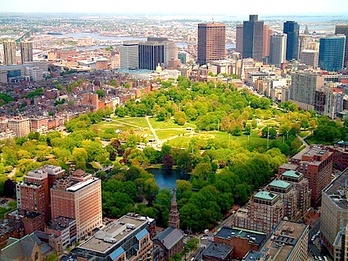Boston Common - Boston, MA

There is no debate that Boston Common is a classic masterpiece and an example of an urban park that works and truly functions in every way it should. Boston Common works on so many levels it could essentially be used as a blueprint for other parks and cities to follow. It is one of the prime destinations in one of most America's most essential and important cities, and deservedly so. The fact that it is the oldest city park in the United States, dating from its creation in 1634, makes it all that more impressive. It is as if the designers of this first urban park had the right idea all along.
The location of the park contributes heavily to its use and importance. It is located in the heart of Boston on 50 prime acres bounded by Tremont, Park, Beacon, Charles, and Boylston Streets. It is located directly to the west of the heart of downtown and borders many other famous neighborhoods, such as Beacon Hill. The state capitol building of Massachusetts also lies on the edge of the park, adding to the air of importance in the atmosphere. Although it has been in continuous use as public land since the 1630s, its use has changed over time. It started as a common area for many different people to use as a cow pasture, hence the use of the name Common instead of park. For the first two centuries of it existence, it was more used as a shared public space and gathering spot than a true park. For example, the British used the area as a camp for troops in the build-up to the Revolutionary War. Also, the area was a popular spot for public hangings until the early 1800s. By the 1830s, a transition was made towards true park status, a time which coincided with the full removal of cow grazing from its boundaries.
Today, the park plays an essential role in the daily function of Boston. It is a large green space in the middle of a highly dense urban environment. It is an area enjoyed by people all across the socioeconomic spectrum. It is heavily used for exercise, recreation, relaxation, public events, and both formal and informal gatherings. It is also a destination unto itself as part of Boston's famous Freedom Trail winds through its boundaries. The park affords excellent views of the surrounding cityscape and skyline. While the park is well landscaped and features grand monuments, it is relatively simple in design. In many ways, it can be argued that less is better as there is more space for public use and less cost for maintenance on the city's part.
Boston Common serves as a much needed natural oasis in the heart of hectic and crowded Boston life and offers so much more. Not much more can be asked for from an urban park of its size and location.
The location of the park contributes heavily to its use and importance. It is located in the heart of Boston on 50 prime acres bounded by Tremont, Park, Beacon, Charles, and Boylston Streets. It is located directly to the west of the heart of downtown and borders many other famous neighborhoods, such as Beacon Hill. The state capitol building of Massachusetts also lies on the edge of the park, adding to the air of importance in the atmosphere. Although it has been in continuous use as public land since the 1630s, its use has changed over time. It started as a common area for many different people to use as a cow pasture, hence the use of the name Common instead of park. For the first two centuries of it existence, it was more used as a shared public space and gathering spot than a true park. For example, the British used the area as a camp for troops in the build-up to the Revolutionary War. Also, the area was a popular spot for public hangings until the early 1800s. By the 1830s, a transition was made towards true park status, a time which coincided with the full removal of cow grazing from its boundaries.
Today, the park plays an essential role in the daily function of Boston. It is a large green space in the middle of a highly dense urban environment. It is an area enjoyed by people all across the socioeconomic spectrum. It is heavily used for exercise, recreation, relaxation, public events, and both formal and informal gatherings. It is also a destination unto itself as part of Boston's famous Freedom Trail winds through its boundaries. The park affords excellent views of the surrounding cityscape and skyline. While the park is well landscaped and features grand monuments, it is relatively simple in design. In many ways, it can be argued that less is better as there is more space for public use and less cost for maintenance on the city's part.
Boston Common serves as a much needed natural oasis in the heart of hectic and crowded Boston life and offers so much more. Not much more can be asked for from an urban park of its size and location.

